Mical1 deletion in tyrosinase expressing cells affects mouse running gaits
- PMID: 39344934
- PMCID: PMC11440367
- DOI: 10.1111/gbb.70004
Mical1 deletion in tyrosinase expressing cells affects mouse running gaits
Abstract
Neuronal development is a highly regulated process that is dependent on the correct coordination of cellular responses to extracellular cues. In response to semaphorin axon guidance proteins, the MICAL1 protein is stimulated to produce reactive oxygen species that oxidize actin on specific methionine residues, leading to filamentous actin depolymerization and consequent changes in neuronal growth cone dynamics. Crossing genetically modified mice homozygous for floxed Mical1 (Mical1fl/fl) alleles with transgenic mice expressing Cre recombinase under the control of a tyrosinase gene enhancer/promoter (Tyr::Cre) enabled conditional Mical1 deletion. Immunohistochemical analysis showed Mical1 expression in the cerebellum, which plays a prominent role in the coordination of motor movements, with reduced Mical1 expression in Mical1fl/fl mice co-expressing Tyr::Cre. Analysis of the gaits of mice running on a treadmill showed that both male and female Mical1fl/fl, Tyr::Cre mutant mice had significant alterations to their striding patterns relative to wild-type mice, although the specific aspects of their altered gaits differed between the sexes. Additional motor tests that involved movement on a rotating rod, descending a vertical pole, or crossing a balance beam did not show significant differences between the genotypes, suggesting that the effect of the Mical1fl/fl, Tyr::Cre genetic modifications was only manifested during specific highly coordinated movements that contribute to running. These findings indicate that there is a behavioral consequence in Mical1fl/fl, Tyr::Cre mutant mice that affects motor control as manifested by alterations in their gait.
Keywords: Mical1; actin; cytoskeleton; gait; genetic modification; reactive oxygen species; running; stride; tyrosinase.
© 2024 The Author(s). Genes, Brain and Behavior published by International Behavioural and Neural Genetics Society and John Wiley & Sons Ltd.
Conflict of interest statement
The authors declare no conflict of interest.
Figures
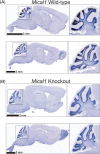

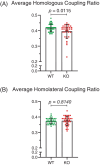

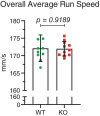
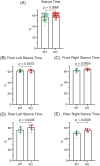
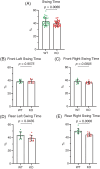
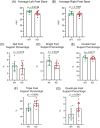

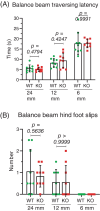
Similar articles
-
MICAL1 regulates actin cytoskeleton organization, directional cell migration and the growth of human breast cancer cells as orthotopic xenograft tumours.Cancer Lett. 2021 Oct 28;519:226-236. doi: 10.1016/j.canlet.2021.07.039. Epub 2021 Jul 24. Cancer Lett. 2021. PMID: 34314753
-
MICAL1 inhibits colorectal cancer cell migration and proliferation by regulating the EGR1/β-catenin signaling pathway.Biochem Pharmacol. 2022 Jan;195:114870. doi: 10.1016/j.bcp.2021.114870. Epub 2021 Dec 11. Biochem Pharmacol. 2022. PMID: 34902339
-
MICAL1 Monooxygenase in Autosomal Dominant Lateral Temporal Epilepsy: Role in Cytoskeletal Regulation and Relation to Cancer.Genes (Basel). 2022 Apr 19;13(5):715. doi: 10.3390/genes13050715. Genes (Basel). 2022. PMID: 35627100 Free PMC article. Review.
-
Tyrosinase-Cre-Mediated Deletion of the Autophagy Gene Atg7 Leads to Accumulation of the RPE65 Variant M450 in the Retinal Pigment Epithelium of C57BL/6 Mice.PLoS One. 2016 Aug 18;11(8):e0161640. doi: 10.1371/journal.pone.0161640. eCollection 2016. PLoS One. 2016. PMID: 27537685 Free PMC article.
-
Properties and catalytic activities of MICAL1, the flavoenzyme involved in cytoskeleton dynamics, and modulation by its CH, LIM and C-terminal domains.Arch Biochem Biophys. 2016 Mar 1;593:24-37. doi: 10.1016/j.abb.2016.01.016. Epub 2016 Feb 1. Arch Biochem Biophys. 2016. PMID: 26845023
References
-
- Cheever TR, Ervasti JM. Actin isoforms in neuronal development and function. Int Rev Cell Mol Biol. 2013;301:157‐213. - PubMed
-
- Goellner B, Aberle H. The synaptic cytoskeleton in development and disease. Dev Neurobiol. 2012;72(1):111‐125. - PubMed
-
- Schneider F, Metz I, Rust MB. Regulation of actin filament assembly and disassembly in growth cone motility and axon guidance. Brain Res Bull. 2023;192:21‐35. - PubMed
MeSH terms
Substances
Grants and funding
LinkOut - more resources
Full Text Sources

